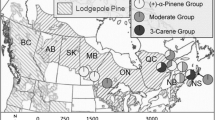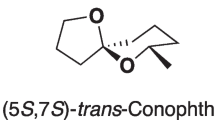Abstract
The three components of the European elm bark beetle pheromone dispensed from polyethylene vials attached to the boles of healthy juvenile elms affected the rates of beetles landing and twig feeding on the baited trees. Maximum attraction to the tree occurred when all three pheromone components were presented together in a ratio of 1∶1∶8 for 4-methyl-3-heptanol (H), α-multistriatin (M), and α-cubebene (C). M released either alone or in excess of its natural ratio with H and C induced twig-crotch feeding. H presented alone had no effect on attraction or twig-crotch feeding, but in combination with M it induced landing on and boring into the tree bole. We concluded that the ratio of M and H being released influenced incoming beetles either to land on and colonize the bole or to feed in twig crotches. M in excess of H, known to occur when most females are mated, terminates colonization and deflects incoming beetles to crowns of elms.
Similar content being viewed by others
References
Bartels, J.M., andLanier, G.N. 1974. Emergence and mating inScolytus multistriatus (Coleoptera: Scolytidae).Ann. Entomol. Soc. Am. 67:365–370.
Collins, D.L. 1938. Feeding habits ofScolytus multistriatus (Marsham) with reference to the Dutch elm disease.Econ. Entomol. 31:196–200.
Cuthbert, R.A., andPeacock, J.W. 1978. Response of the elm bark beetle,Scolytus multistriatus (Coleoptera: Scolytidae), to component mixtures and doses of the pheromone, multilure.J. Chem. Ecol. 4:363–373.
Elliott, E.W., Lanier, G.N., andSimeone, J. B. 1975. Termination of aggregation by the European elm bark beetle,Scolylus multistriatus.J. Chem. Ecol. 1:283–289.
Elliott, W.J., Hromnak, G., Fried, J., andLanier, G.N. 1979. Synthesis of multistriatin enantiomers and their action onScolytus multistriatus (Coleoptera: Scolytidae).J. Chem. Ecol. 5:279–287.
Gore, W.E., Pearce, G.T., Lanier, G.N., Simeone, J.B., Silverstein, R.M., Peacock, J.W., andCuthbert, R. A. 1977. Aggregation attractant of the European elm bark beetle,Scolytus multistriatus: Production of individual components and related aggregation behavior.J. Chem. Ecol. 3:429–446.
Lanier, G.N. 1979. Protection of elm groves by surrounding them with multilure-baited sticky traps.Bull. Entomol. Soc. Am. 25:109–111.
Lanier, G.N. 1981. Pheromone-baited traps and trap trees in the integrated management of bark beetles in urban areas, pp. 115–131,in E.R. Mitchell (ed.). Management of Insect Pests with Semiochemicals. Plenum Publ. Co., New York.
Lanier, G.N., Silverstein, R.M., andPeacock, J.W. 1976. Attractant pheromone of the European elm bark beetle (Scolytus multistriatus): Isolation, identification, synthesis and utilization studies, pp. 149–175, in J.E. Anderson and H.K. Kaya (eds.). Perspectives in Forest Entomology. Academic Press, New York.
Lanier, G.N., Gore, W.E., Pearce, G.T., Peacock, J.W., andSilverstein, R.M. 1977. Responses of the European elm bark beetle,Scolytus multistriatus (Coleoptera: Scolytidae) to isomers and components of its pheromone.J. Chem. Ecol. 3:1–8.
Martin, C.H. 1936. Preliminary report of trap log studies on elm bark beetles.J. Econ. Entomol. 29:297–306.
Meyer, H. J., andNorris, D.M. 1967. Behavioral responses byScolytus muhistriatus (Coleoptera: Scolytidae) to host- (Ulmus) and beetle-associated chemotactic stimuli.Ann. Entomol. Soc. Am. 60:642–647.
Mori, K. 1977. Absolute configuration of (−)-4-methyl-heptan-3-ol, a pheromone of the smaller European elm bark beetle, as determined by the synthesis of its (3R, 4R)-(+)- andf(3S, 4R)-(+) isomers.Tetrahedron 33:209–294.
O'Callaghan, D.P., Gallagher, E.M., andLanier, G.N. 1980. Field evaluation of pheromone-baited trap trees to control elm bark beetles, vectors of the Dutch elm disease.Environ. Entomol. 9:181–185.
Peacock, J.W., Lincoln, A.C., Simeone, J.B., andSilverstein, R.M. 1971. Attraction ofScolyius multistriatis (Coleoptera: Scolytidae) to a virgin female-produced pheromone in the field.Ann. Entomol. Soc. Am. 64:1143–1149.
Peacock, J.W., Cuthbert, R.A., andLanier, G.N. 1981. Deployment of traps in a barrier strategy to reduce populations of the European elm bark beetle, and the incidence of Dutch elm disease, pp. 155–174,in E.R. Mitchell (ed.). Management of Insect Pests with Semiochemicals. Plenum Pub. Co., New York.
Pearce, G.T., Gore, W.E., Silverstein, R.M., Peacock, J.W., Cuthbert, R.A., Lanier, G.N., andSimeone, J.B. 1975. Chemical attractants for the smaller European elm bark beetleScolytus multistriatus (Coleoptera: Scolytidae).J. Chem. Ecol. 1:115–124.
Prokopy, R.J. 1981. Epideictic pheromones that influence spacing patterns of phytophagous insects, pp. 181–213,in D.A. Nordlund, R.I. Jones, and W.J. Lewis (eds.). Semiochemicals: Their Role in Pest Control. J. Wiley & Sons, New York.
Rabaglia, R.J., andLanier, G.N. 1983. Within-tree distribution of twig-crotch feeding byScolytus muhistriatus, and sampling for area-wide intensity.Can. Entomol. In Press.
Reidl, H.W., andButcher, J.W. 1975. Aspects of the feeding behavior ofScolytus multistriatus (Marsham) (Scolytidae: Coleoptera) and implications for control.Great L.akes Entomol. 8:139–144.
Rudinsky, J.A. 1973. Multiple functions of the southern pine beetle pheromone verbenone.Environ. Entomol. 2:511–514.
Rudinsky, J.A., Morgan, M., Libbey, L.M., andMichael, R.R. 1973. Sound production in Scolytidae: 3-Methyl-2-cyclohexane-l-one released by the female Douglas-fir beetle in response to male sonic signal.Environ. Entomol. 2:505–509.
Švihra, P., andClark, J.K. 1980. The courtship of the elm bark beetle.Calif. Agric. 1980:7–9.
Wolfenbarger, D.O., andBuchannan, W.D. 1939. Notes on elm twig crotch injuries produced byScolytus multistriatus (Marsham).J. Econ. Entomol. 32:377–381.
Author information
Authors and Affiliations
Additional information
Scolytus multistriatus (Coleoptera: Scolytidae).
Rights and permissions
About this article
Cite this article
Rabaglia, R.J., Lanier, G.N. Effects of multilure components on twig-crotch feeding by European elm bark beetles. J Chem Ecol 9, 1513–1523 (1983). https://doi.org/10.1007/BF00988417
Received:
Revised:
Issue Date:
DOI: https://doi.org/10.1007/BF00988417




